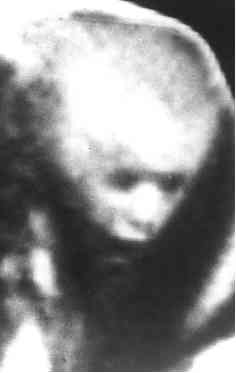Guidebooks to haunted places usually organize their contents according to geographic criteria or to the main
types of "paranormal" events a visitor is invited to expect. This chapter is intended as an introductory guide to the most
frequently and thoroughly haunted site, indeed, the cradle from which all hauntings ultimately emerge. It is the human brain.
Peter Brugger addresses the nature of the human being to believe he is the agent of a behaviour (he gives "facilitated communication", that wellknown con in autism, as an example), and "how smooth the transitions are from individual
delusions to the madness of crowds". The other mechanism of pseudoscience he deals with is "the pervasive tendency of human beings to see order in random configurations".
As a case study in the former, the tale of Ludwig Staudenmaier is given. Ludwig was initially ordained, and then became a 19th century scientist who became fascinated by the then trendy phenomenon of seances (oh, how little things change!), and then became a convinced believer:
Staudenmaier's initial insight into the central nervous system origin of his perceptual experiences slowly vanished. He was convinced of the possibility of photographing his visual hallucinations and is thus an unappreciated precursor of the more modern protagonists of "thoughtography" . He was also convinced of the possibility to move objects by means of his will, although he admitted that at times the arm of the balance he tried to psychokinetically manipulate in one direction maliciously moved in the opposite direction. Such instances of PSI-missing (as modern parapsychologists would label the phenomenon) were occasionally followed by the appearance of a gnome sitting on the balance and grimacing at him, seemingly ridiculing his failed endeavor -- Staudenmaier had definitely lost the sense for the borders between perception and imagination, between experience and belief, and between volition and automaticity.
The same thing has happened with the burgeoning of "facilitated communication" (FC):
Nourished by the poltergeist within (the unconscious guidance of another person's hand), FC has thus
developed into a truly large-scale haunting. Propagators of FC behave like little Staudenmaiers; they are playing around
with a pervasive, powerful force the agency of which they deny. Like Staudenmaier, they have, as a community, lost the
sense of the borders between magic and science.
As a case study in randomness and order, the example of August Strindberg is offered, and his writings describing his own psychotic episodes.
The disastrous aspects of Strindberg's psychotic crisis involved painstaking delusions of persecution, encompassing the fear of being tortured, paralyzed or killed by electric currents, and a sometimes barely controllable urge to commit suicide. Those aspects of Strindberg's psychosis which certainly offered an "opportunity" to his writings are best captured in what is considered a key symptom of florid psychotic experience, i.e., a hightened awareness of the "meaningfulness" and personal relevance of any event together with the absolute conviction that no two things in the world are devoid of meaningful connections. Conrad (1958) coined the term "apophenia" for this manner of seeing and interpreting the world. He defined apophenia as the "unmotivated seeing of connections" accompanied by a "specific experience of an abnormal meaningfulness" (p.46). Table 2 (see pages 17-18) presents selected descriptions of apophenic reactions from Strindberg's Inferno and From an Occult Diary (Strindberg, 1897/1979). The instances listed in Table 2 were elicited by visual stimuli of either highly ambiguous character (such as the formation of clouds, the patterns observed in rocks and pieces of wood, or the folds in a pillow) or whose spatial arrangement invites inferences of non-random origins (e.g., fallen twigs seem to form a symbolic shape, the arrangement of furniture is felt to carry a message). Apart from these visuo-spatial triggers of apophenia, Strindberg also described a vast number of temporal coincidences, of which Table 2 contains only one characteristic instance, i.e. the reading of the word "thunder" in a Bible verse coinciding with a clap of thunder during a storm.
As a final example, a computer tomography image of a "haunted scrotum" is presented:

Figure 5 (from Harding, 1996) provides a final visual summary of the main points discussed in this chapter's
three sections: (1) poltergeists are confined to one's own body, (2) an overinterpretation of patterns in chaos may give
the impression that they are "out there", and (3) as long as not indicative of obvious pathology, any ghosts would best
be met with a good portion of humor.
Of course, it may not be a testicular ghost. EoR has a nasty feeling it looks exactly like an alien implant!
No comments:
Post a Comment
Note: only a member of this blog may post a comment.